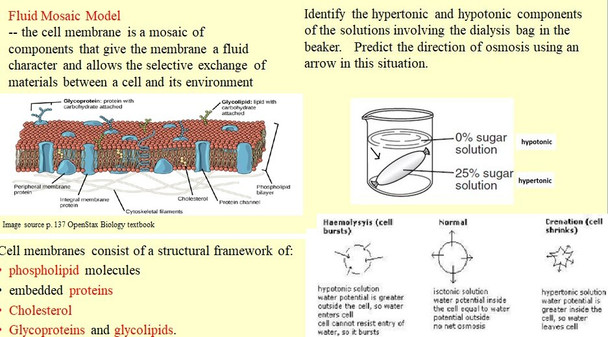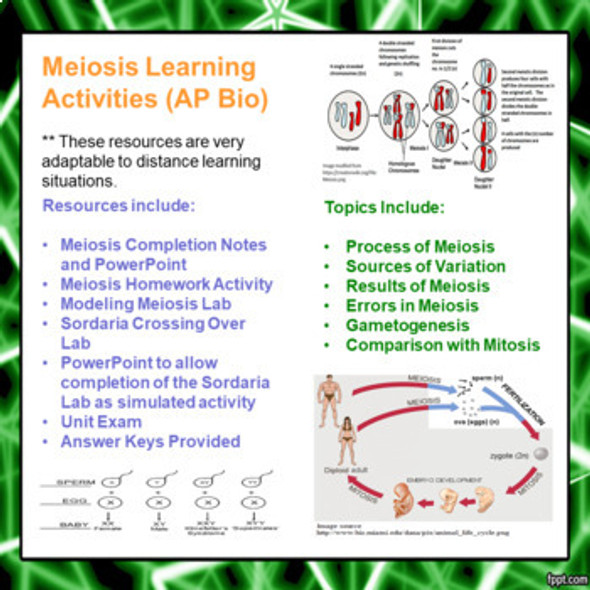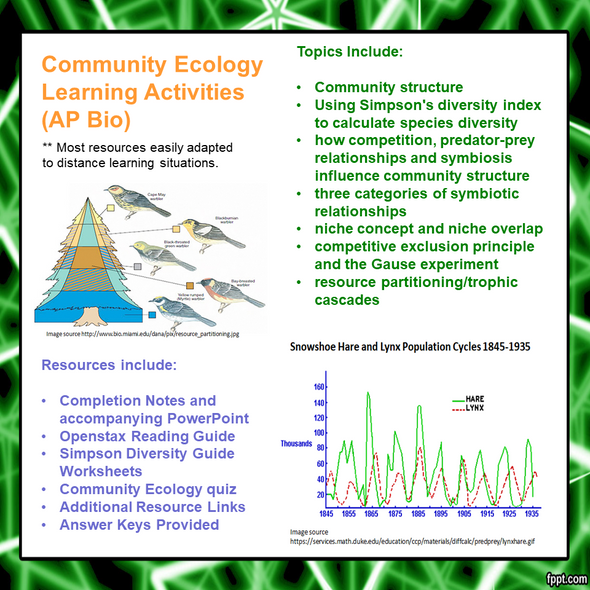Membrane Learning Activities for AP Biology (Distance Learning)
- Bulk Pricing:
- Buy in bulk and save
- Contributor:
- Monday's Rescue
- Grade Level:
- 9-12
- Product Type:
- Learning Package (Notes, PowerPoint, Homework)
- File Type:
- doc, pdf, ppt
- Pages:
- 36
- Answer Key:
- Yes
Description
This zip file contains many different activities (36 pages of student handouts and a PowerPoint with a total of 59 slides) which can be used to compose a unit for AP Biology or advanced Biology students involving the major topics of Cell Membranes and Membrane Processes. Topics in this unit include cell surface area and volume considerations and calculations, introduction to the properties of the cell membrane, tonicity, diffusion, osmosis and active transport, types of active transport, water potential, as well as many other topics. More specifics concerning the topics addressed in this package of activities appear in the objectives at the end of this description. The learning objectives and materials have been updated to meet the requirements of the 2019-2020 school year by the Educational Testing Service. The materials have been completely updated to meet the requirements of the 2019-2020 curriculum revisions for AP Biology.
This lesson packet contains a listing of the learning goals, common core learning standards, NGSS learning standards and the AP Biology performance indicators addressed in these materials. These are included in the packet and at the end of the description of this lesson. The learning guides/assignments contain links to online resources to support student learning.
Most documents are included in both word and pdf format to allow editing for specific teacher needs. These learning materials are well suited for a distance learning situation.
Suggested answer keys are included for all items.
The specific contents of the learning package includes the following items (the page count for these items are actual student handouts as answer key page counts are not included):
-- Membrane Processes PowerPoint (59 slides)
-- Completion Notes to accompany the PowerPoint (14 pp)
-- Cell Membrane Function and Processes Learning Objectives (ETS, Local, NGSS and Common Core)
-- Membranes and Membrane Processes Reading Assignment using free online OpenStax Biology text or resource of your choice (9 pp/51 questions)
-- Membrane Processes Exam (9 pp/50 questions)
-- Additional Online Resources (2 pp)
Cell Membrane Structure and Processes Learning Objectives ETS
Enduring Understanding
ENE-1 The highly complex organization of living systems requires constant input of energy and the exchange of macromolecules.
ENE-2 Cells have membranes that allow them to establish and maintain internal environments that are different from their external environments.
Learning Objective
ENE-1.B Explain the effect of surface area-to-volume ratios on the exchange of materials between cells or organisms and the environment.
ENE 1.C Explain how specialized structures and strategies are used for the efficient exchange of molecules to the environment.
ENE-2.A Describe the roles of each of the components of the cell membrane in maintaining the internal environment of the cell.
ENE-2.B Describe the Fluid Mosaic Model of cell membranes.
ENE-2.C Explain how the structure of biological membranes influences selective permeability.
ENE-2.D Describe the role of the cell wall in maintaining cell structure and function.
ENE-2.E Describe the mechanisms that organisms use to maintain solute and water balance.
ENE-2.F Describe the mechanisms that organisms use to transport large molecules across the plasma membrane.
ENE-2.G Explain how the structure of a molecule affects its ability to pass through the plasma membrane.
ENE-2.H Explain how concentration gradients affect the movement of molecules across membranes.
ENE-2.I Explain how osmoregulatory mechanisms contribute to the health and survival of organisms.
ENE-2.J Describe the processes that allow ions and other molecules to move across membranes.
Cell Membrane Structure and Processes Learning Goals (local)
Upon completion of this unit the student will be able to:
1. describe the following different kinds of cellular transport utilized in the living cell; diffusion, osmosis, facilitated diffusion.
2. explain the difference between hypertonic, isotonic, and hypotonic solutions.
3. explain osmosis and diffusion situations based on concentration differences in living things.
4. distinguish and describe the differences between active transport and passive transport.
5. describe the ways small particles and dissolved macromolecules are ingested by the cell; pinocytosis and phagocytosis.
6. explain what is meant by a carrier molecule and facilitated diffusion.
7. describe the role of aquaporins in the cell membrane.
8. define each of the following terms; permeases, exocytosis, cell sap, turgor, wilt, and osmotic potential.
9. explain what is meant by receptor mediated endocytosis and exocytosis.
NGSS Standard
HS-LS1-3. Plan and conduct an investigation to provide evidence that feedback mechanism maintain homeostasis.
Common Core State Standards Connections:
ELA/Literacy
RST.11-12.1 Cite specific textual evidence to support analysis of science and technical texts, attending to important distinctions the author makes and to any gaps or inconsistencies in the account.
WHST.9-12.7 Conduct short as well as more sustained research projects to answer a question (including a self-generated question) or solve a problem; narrow or broaden the inquiry when appropriate; synthesize multiple sources on the subject, demonstrating understanding of the subject under investigation.
WHST.9-12.9 Draw evidence from informational texts to support analysis, reflection, and research.
Mathematics
MP.4 Model with mathematics.
Terms of Use
Purchase of the product is for classroom use by the purchaser only. It is a violation for individuals, schools, and districts to redistribute, sell, or post this item on the Internet or to other individuals.
This work is licensed under a Creative Commons Attribution-NonCommercial-ShareAlike 4.0 International License.
This learning package bundle is part of the AP Biology Complete Course. The complete course contains 22 learning package bundles in addition to this one. Save nearly 60% over the cost of buying 23 individual unit learning bundles with your purchase of the complete course.
Check out Monday's Rescue for more great resources!














